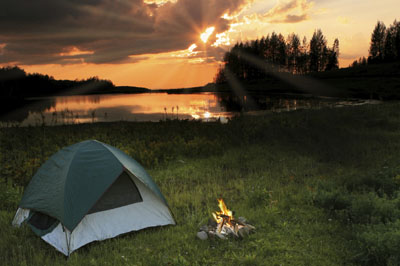
When buying a tent there are many things to consider, as this will be your home away from home while camping. From the type of weather you'll be camping in, to the type of camping you'll be doing, there are many factors that will impact the type of tent that's right for you. That's why it's important to research all your options in terms of size, style and materials used. A little research now will ensure you find a tent that's perfect for you.
What type of camper are you?
If you are a first timer or an occasional camper there's no need to invest in an expensive high-end tent. Consider a moderately priced tent from a reputable manufacturer. You'll get the same amount of enjoyment from it and save yourself some cash. Two brands to consider are Coleman and Eureka!. They both make good quality tents that sell for much less than North Face and MSR products. Eureka! and Coleman products are moderately priced, usually from around $70-$200, depending on which size you choose. Purchasing a second-hand tent is also a great idea; check websites like Ebay and Craigslist. I found a used tent on craigslist that's made to fit over the bed of my truck. You might even get lucky and find one at a garage sale.
However, if you go camping frequently or in all types of weather conditions, consider buying a high-end model. The more you plan to use it, the more money you should spend on it. If you're going camping every weekend or in harsh conditions you could end up buying a cheap tent every few years, which makes no sense. Get a strong, durable tent that will last through many years of use.
What size are you looking for?
Size matters! Choose a tent that's right for its intended purpose. If you are planning a family trip, make sure there's enough room for everyone to sleep comfortably with all your backpacks and gear inside. On the other hand, if you're planning a multiple day backpacking trip you don't want to carry a tent that's too big. The bigger your tent is the heavier it will be and on long hikes every ounce matters. Also, if you're camping in cold weather you don't want a tent that's too big for your party. Two people's body heat will fill up a small tent and keep you warm. Put those same two people in a four or six person tent, with all that extra space, and their body heat will dissipate.
Tents are typically advertised as 2-person, 4-person, 6-person and so on, which means there's enough room for a maximum of 2, 4 or 6 people. If you wish to fit exactly 6 people in a 6-person tent make sure there's a vestibule area outside to keep your gear in. A vestibule is a small space located at the entrance of your tent. It's covered by the rain fly but not exactly inside the tent. The point of the vestibule is to keep your gear out of the way and out of the elements.
Not all tents have vestibules. You can however buy vestibules separately and attach them to your tent or just use a tarp to cover your gear at night. So it's really up to you. However, having a built-in vestibule is the most convenient option. If the tent you like doesn't have a vestibule you can go up a size, from a four person to a six person, or from a six person to an eight person in order to create additional room for gear. If the weight of your tent and cold weather are not major issues, going up a size will always be more comfortable.
What seasons will you go camping the most?
If you are purchasing a tent for the first time, you should consider the type of weather you will most often camp in and base your decisions on that weather.
Two-Season
|
Two-season tents are designed for hot climates only and weigh less than other tents (usually 4 to 8 pounds). Features valued are:
- Mesh in the tent body for ventilation.
- Tent can be set up without the rain fly on clear nights.
- Rain fly that stops inches above the ground to provide maximum protection from the elements and creepy critters, while improving ventilation.
- Two-pole construction.
|
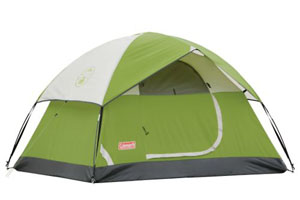 |
Three-Season
|
Three-season tents are built to withstand light snow, warm climates and a variety of conditions in between. Three season tents are versatile enough to be used most of the year. Features valued are:
- Full-coverage rain fly that extends to the ground.
- Large vestibule to accommodate gear.
- Skylight window in the rain fly to let in additional light.
- Sturdy guy-out points sewn to the rain fly for tying down the tent down during wild winds.
- Vents that can be opened or closed.
|
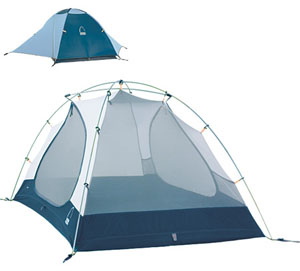 |
All-Season
|
All-season tents can be used year-round but are not designed for harsh winter mountaineering. Features valued are:
- A skylight window in the rain fly to let in additional light.
- Four aluminum poles for freestanding construction. One pole removable option for weight-saving versatility.
- Removable vestibule for weight-saving versatility.
- Mesh with zip-out panels that can be used for ventilation when open, or for protection when closed.
- Rain fly that can be set up by itself, for go-light travel.
- Vestibules, to provide easy entrance and exit as well as gear storage.
|
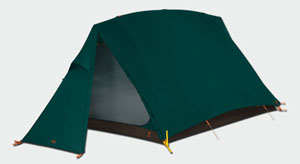 |
Winter or mountaineering tents
|
Winter or mountaineering tents can be used year-round but are not designed for harsh winter mountaineering. Features valued are:
- Aluminum or heavy duty poles.
- Full-coverage rain fly.
- Steep sidewalls to shed rain and snow.
- Two doors on opposite sides.
- Vestibules, to provide easy entrance and exit as well as gear storage.
- Vestibules sometimes have their own poles for support.
- Sturdy guy-out points are sewn into the rain fly for tying down the tent during extreme winds.
- A rain-fly that can be pitched with only the poles to provide a lightweight floorless option or serve as the base of an improvised snow cave.
|
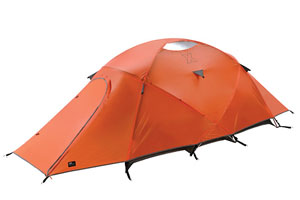 |
Types of tents
One final thing to think about is the style or type of tent. Most people that go tenting camping go for a dome tent but here are all the options available so you're fully informed:
Single-wall tents
|
Single-wall tents are for those who want an ultra-light shelter with minimalist features, but these can be very claustrophobic and stuffy. They do not require a rain fly to protect against moisture as they use vapor pressure to force condensation out. Vertical sidewalls shed rain and high and low ventilation ports afford maximum airflow.
|
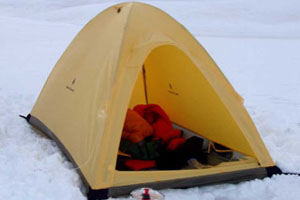 |
Dome tents
|
Dome tents are aerodynamic and stable. They are designed to deflect wind and will handle the snow more effectively. Once the poles are fitted, dome tents are usually free standing, enabling the erected tent to be moved around. The dome is undoubtedly the most popular design for general camping.
|
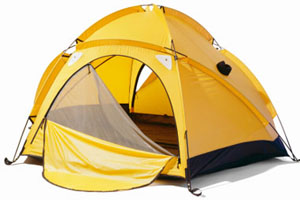 |
Cabin tents
|
Cabin tents are best suited for established campgrounds or base camps. They feature a large, symmetrical design with high ceilings to accommodate cots, chairs, coolers and other creature comforts They are also usually heavier than other designs and more difficult to set up but do provide a lot of space. Due to their size and weight, these tents are best used for car camping, providing space and facilities for large groups and families.
|
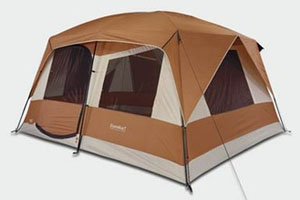 |
Hoop tents
|
Hoop (tunnel) tents are especially popular with hikers because of their excellent space to weight ratio. When guy ropes are properly tied and staked out their low profile offers weather resistance while maximizing interior space.
|
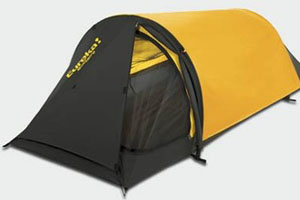 |
Other features to consider
After thinking about what's necessary to accommodate you while camping, consider these other features that will improve your overall comfort and camping experience.
Ventilation. Good ventilation is always important. Large mesh panels allow breezes to flow through your tent in the summer, eliminating condensation while keeping bugs out.
Setup. If your tent is going to be moved daily, easy setup and takedown are important factors. Choosing a tent with shock-corded poles and color coding will significantly reduce set up time.
Fabric. Oftentimes you can determine the overall quality of a tent by the material used. Well-woven nylon is extremely durable and lightweight. Most tents are manufactured using nylon. Polyester is slightly heavier but more tear-resistant and doesn't expand when wet. Canvas is the most durable but is also the heaviest.
Framework. A tents strength and stability begin with the framework. You should choose a tent with sturdy, good quality poles. Good poles should be flexible enough to allow the tent to move under heavy winds without ripping or breaking. Poles can be made of different materials including steel, titanium, fiberglass and carbon fiber. Titanium and carbon fiber are your lightest options. The poles of a tent are generally the heaviest part, so look at the poles when choosing your tent and determine how much weight you are willing to carry. Titanium and carbon fiber poles are lightweight but can be very expensive. Generally, the lighter your tent the more expensive it will be. Of course a tent should fit into your budget but if you plan to go backpacking often, beg borrow and steal to afford a lightweight tent.
Ready to buy a tent?
Once you've figured out what tent's right for you and reviewed the features above, you're well on your way to purchasing that perfect tent. For you next step, check out How to buy a tent.
Happy Tenting!
Copyright ©2012 Camping Road Trip, LLC
Find campgrounds and RV parks - Smart Search Now
Read campground and RV park reviews to help you find the perfect place to stay.